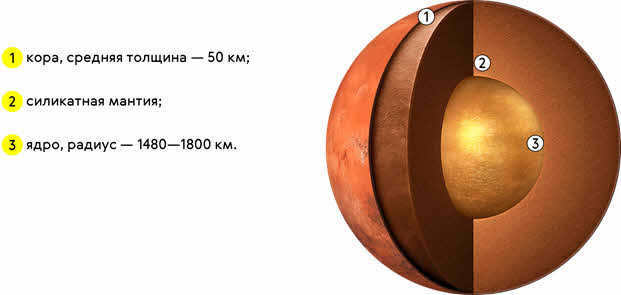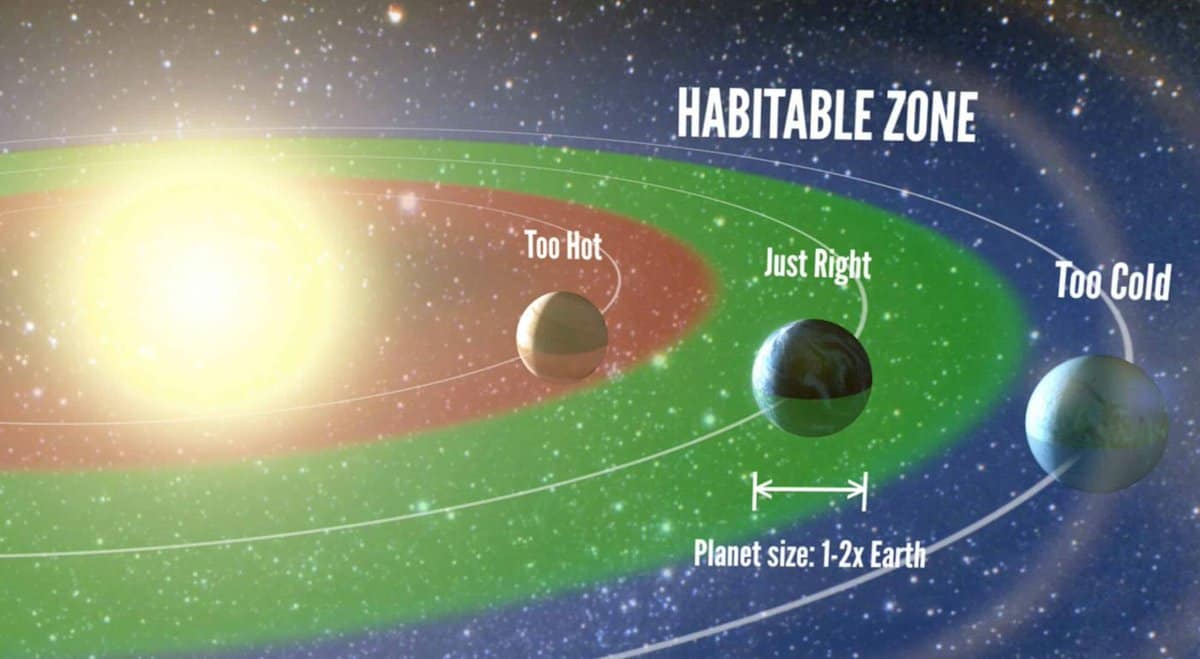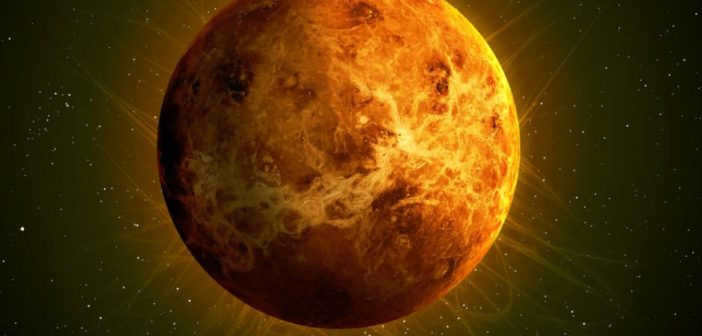
For centuries, humans have been captivated by the vastness of the sky, with its endless clouds, radiant sun, and boundless blue expanse. The enigma of what lies beyond the sky continues to intrigue us. It wasn’t until the past century that the first astronauts ventured into the celestial realm and beheld our planet in the vastness of space, along with its moon, comets, and a myriad of other celestial bodies. Among this vast array of unexplored wonders were the other planets, which were later categorized as terrestrial and non-terrestrial planets.
What are the terrestrial planets in the solar system?
Within the solar system, there are 8 planets, each with unique characteristics such as size, distance from the Sun, and planetary classification. Despite the vastness and mystery of the universe, scientists have managed to classify these planets into two main groups: terrestrial and non-terrestrial. The terrestrial planets consist of the first four planets located closest to the Sun, namely Earth, Mars, Venus, and Mercury.
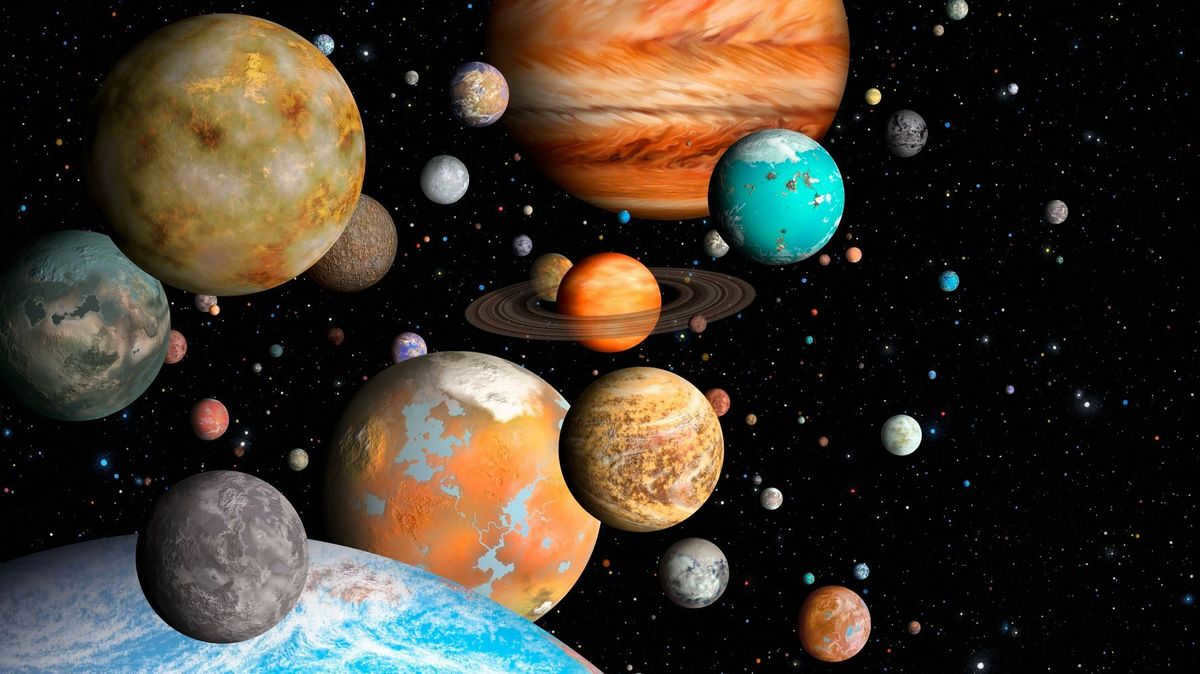
All the planets in the terrestrial planetary group share a similar structure, consisting of a core, mantle, and crust covering the surface. However, not all of them have a solid upper surface. Mercury, for example, lacks a solid upper surface due to constant meteorite bombardment. As a result, space expeditions have never been able to successfully land on Mercury.
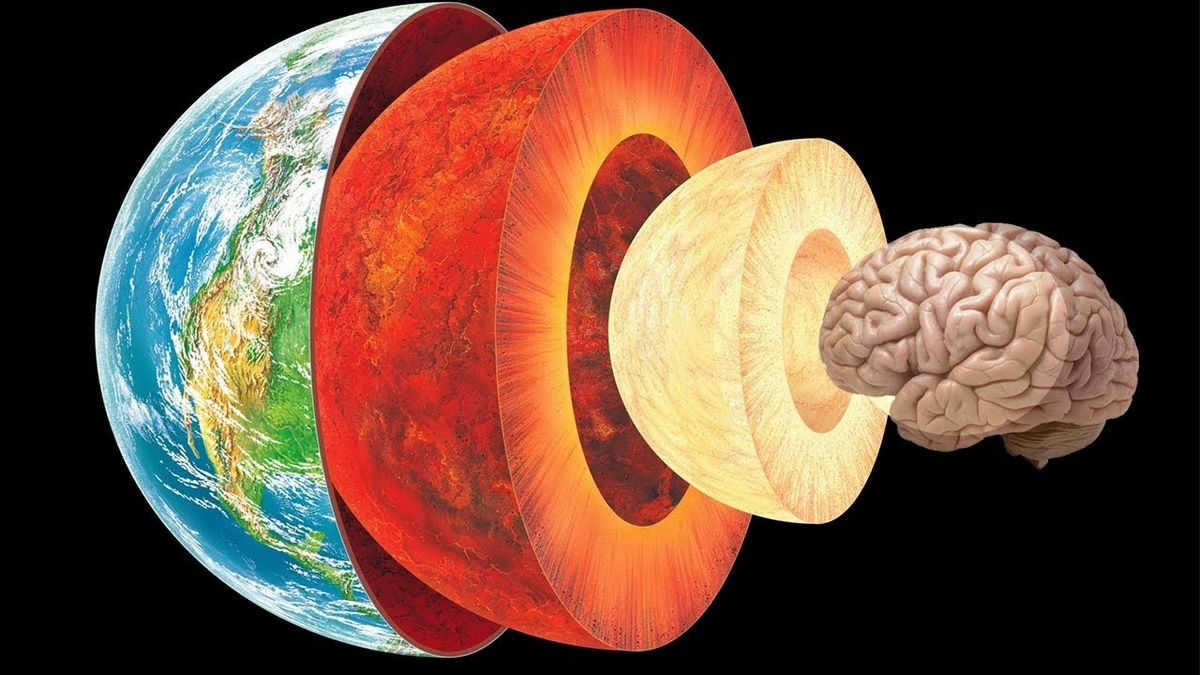
Within the vast expanse of the explored cosmos, a few celestial bodies bear a striking resemblance to the planets found in the Earth’s realm, primarily due to their unique density characteristics. Among these are the dwarf planets Ceres and Pluto. Interestingly enough, these objects possess a dense outer layer, making it theoretically possible to land on them; however, their lithospheric surface is composed of ice. Conversely, the remaining planets outside the Earth-like category exhibit a distinct structure. Instead of being comprised of silicate and iron rocks, these planets are brimming with a mixture of dust, ice fragments, and various gases such as hydrogen, helium, and methane. It is due to this distinguishing attribute that these distant planets have been dubbed Gas Giants.
The main characteristics of the planets
The planets belonging to the Earth group share several common features. Apart from being positioned close to one another and orbiting around the Sun, these planets exhibit similarities in terms of their structure, appearance, and certain properties:
- Position. The planets of the Earth group are situated in the inner region of our solar system, which is sometimes referred to as the first level by scientists. All of these planets are located prior to the asteroid belt;
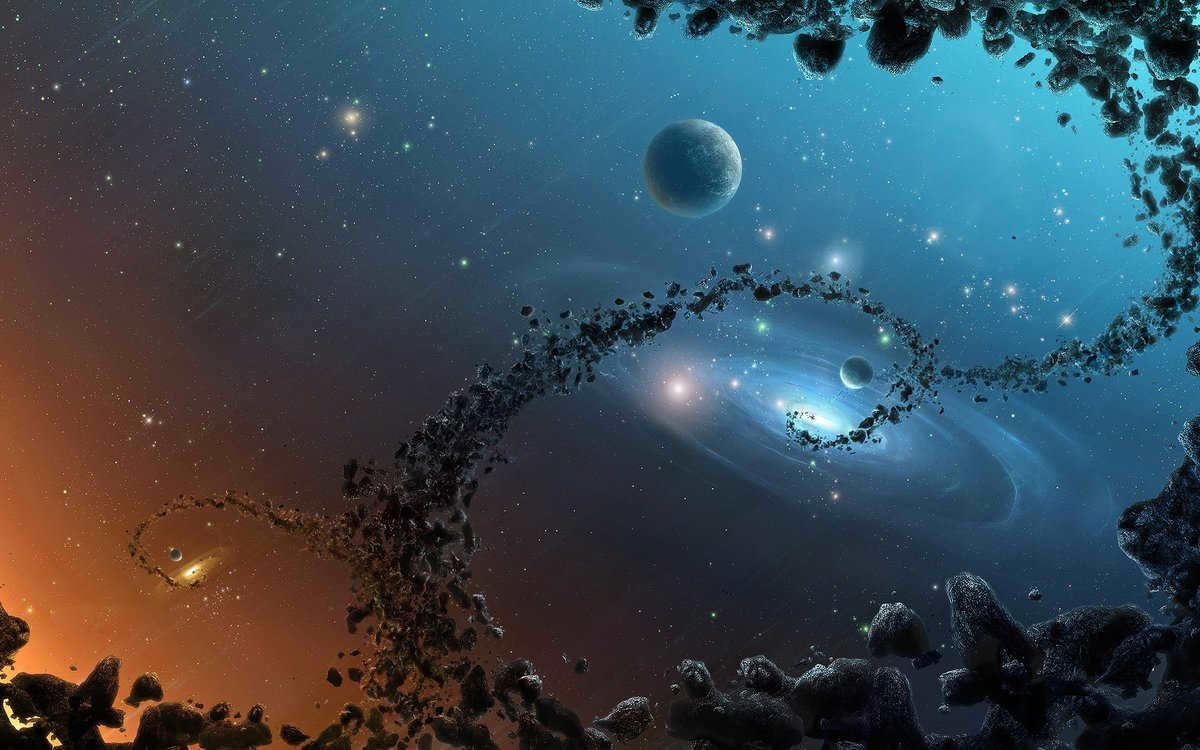
- Planetary Sizes: Earth, Mars, Venus, and Mercury are classified as small planets, while the planets beyond the asteroid belt are considered giant planets. The planets within the Earth group share similar sizes;
- Composition: All four planets have a comparable composition. Each of them consists of a core, mantle, and crust. However, Mercury lacks an outer layer. This is due to the impact of asteroids during the planet’s formation, which caused the lithosphere to break and expose the mantle. The solidified surface layer is evidence of this event. Another possible explanation for the absence of a solid surface on Mercury is volcanic activity, which has gradually eroded the planet’s surface over time;
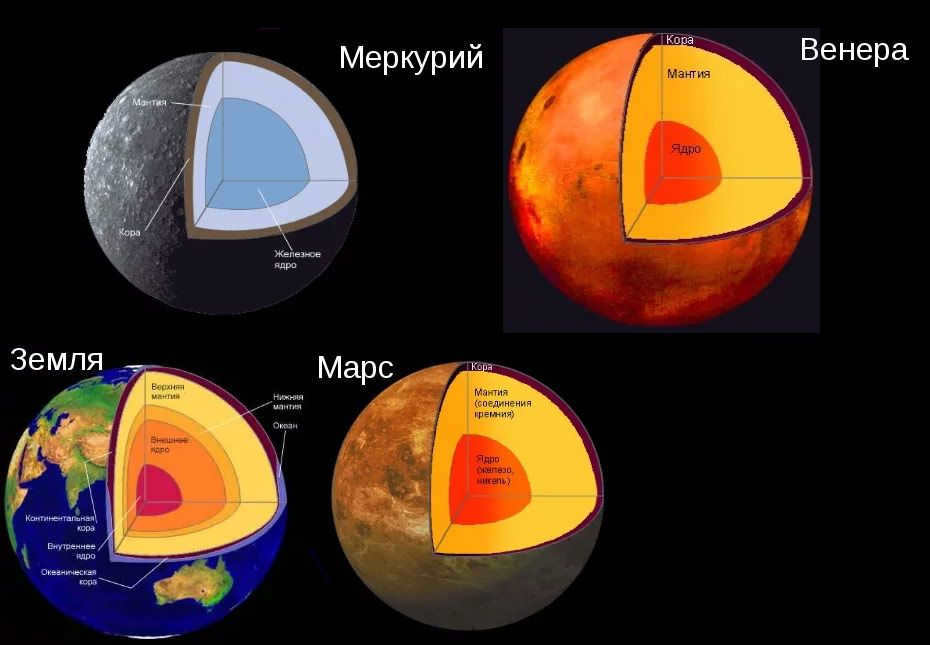
- Chemical composition. The planets belonging to the Earth group share a similar internal structure and have a comparable elemental composition. The majority of the rocks consist of silicon compounds (silicates) and iron;
- Atmosphere. It can be accurately stated that the first four planets possess their own atmospheres. The density of these atmospheres varies, with some planets having a lower density while others have a higher density. For instance, Mercury has virtually no atmosphere, but it bears a resemblance to the atmosphere of the Moon. On the other hand, Mars and Venus have significantly dense atmospheres, which contain carbon dioxide and water vapor, resembling Earth’s gaseous envelope;
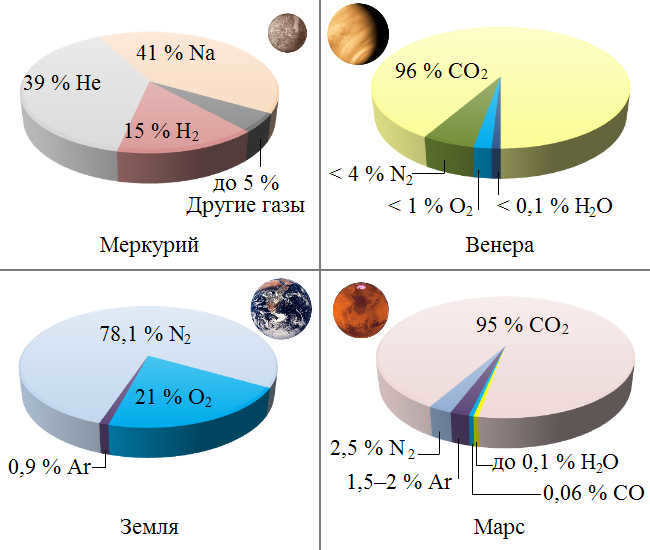
- Satellites. The terrestrial group of planets is known for having a limited number of satellites. The Earth has one satellite, while Mars has two, although they are quite small. Due to this characteristic, the first four planets are referred to as satellites of the sun, as they all orbit around the large star as satellites;
- Rotation. The trajectory of the rotation differs among the planets in the Earth group. Earth and Venus rotate in nearly perfect circles, whereas Mars and Mercury have more elongated orbits.
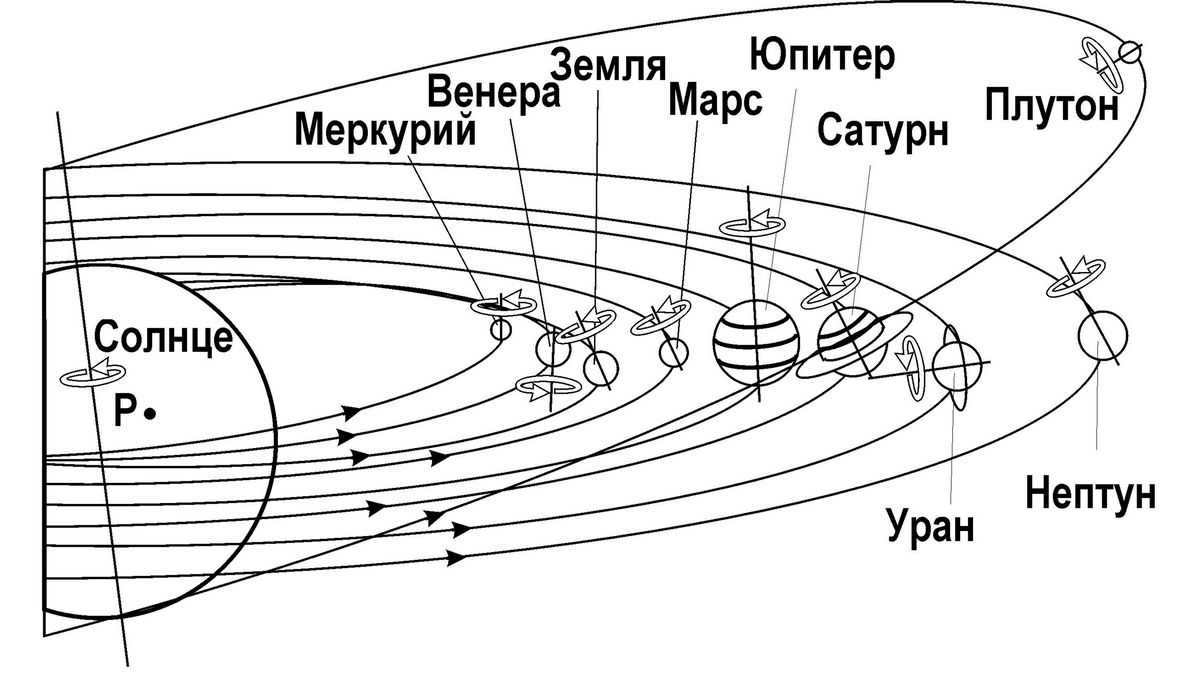
Distinctive Features of Planetary Satellites
When it comes to planetary satellites, it is the giant planets that boast a rich assortment compared to the small Earth-type planets. Currently, we are aware of two satellites accompanying the Earth (Moon) and Mars (Phobos, Deimos). Among these, the Moon holds a special place in the hearts of Earth’s inhabitants. This magnificent celestial body graces our skies, exerts a profound influence on the world’s oceans, and has been the subject of extensive exploration in outer space.
The Earth’s Natural Satellite
Astronomers have been studying the Earth for centuries. Since ancient times, scientists have believed that the Earth is affected by a celestial object that governs the tides and plays a role in eclipses. These theories have proven to be accurate. The celestial object responsible for these phenomena is none other than the Moon, the Earth’s one and only officially recognized natural satellite.
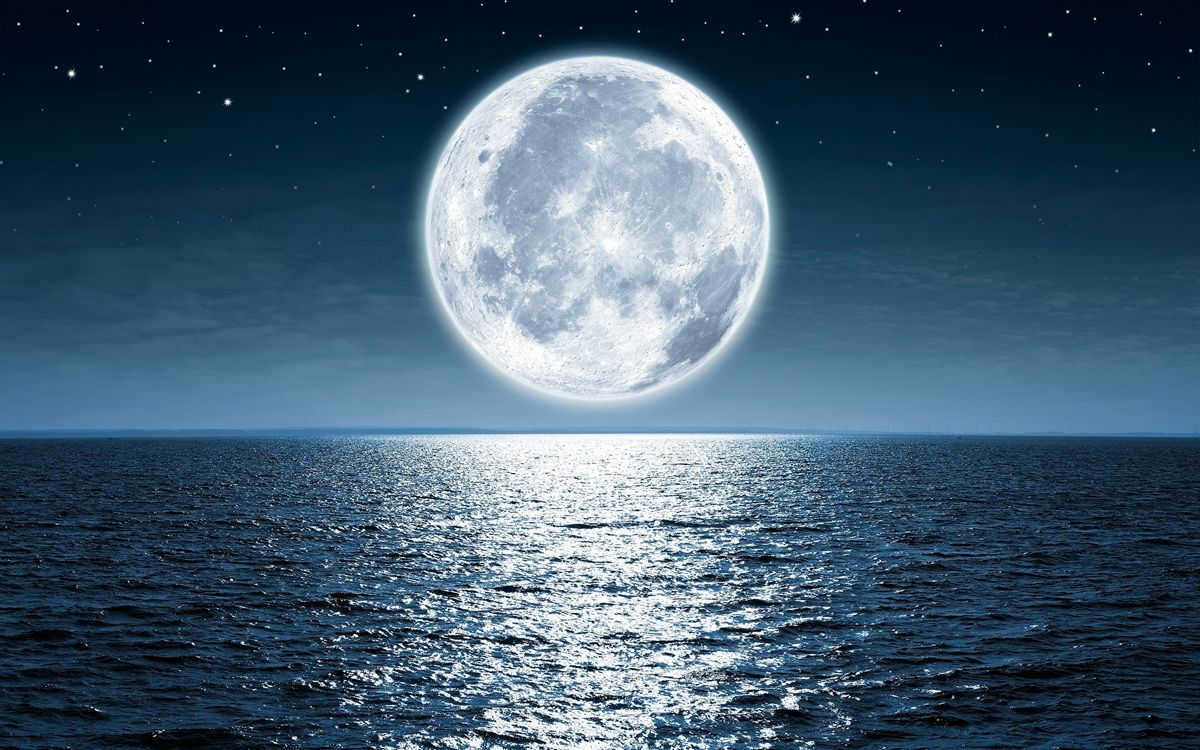
Occasionally, astronomers have differing opinions when it comes to the existence of other moons, mistakenly identifying them as quasi-satellites, asteroids, and other near-Earth objects that may intersect in orbital space. However, it is important to note that all of these entities orbit around the Sun, while the Moon remains in orbit around the Earth.
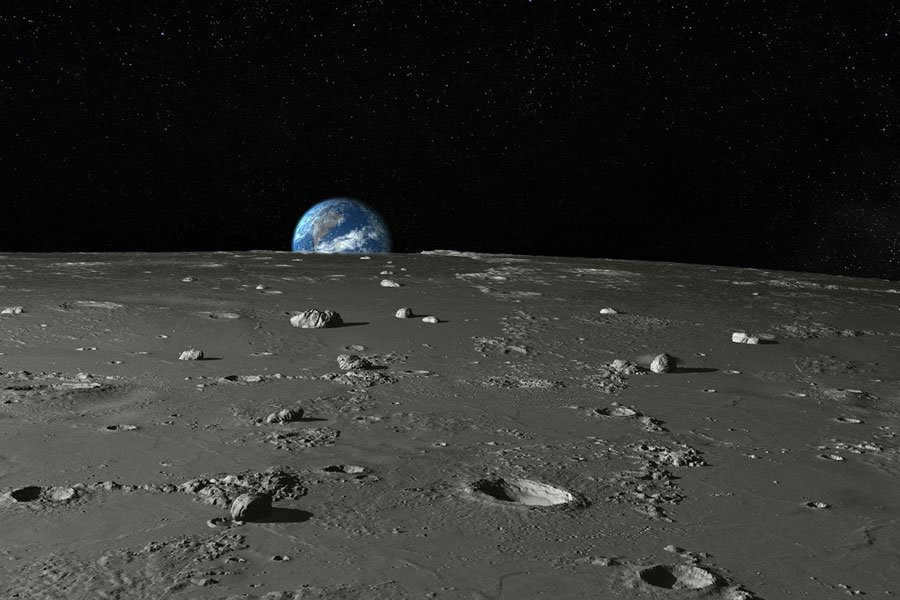
Similar to the Earth, the Moon possesses a core within its composition, accompanied by three layers of mantle and a lunar crust on the surface. Notably, the Moon’s surface is not homogeneous, and this can be observed even from our planet using a basic telescope. Due to the absence of an atmospheric layer, the Moon’s surface is susceptible to meteorite impacts. If the Moon were enveloped by a dense air layer, meteorites would easily disintegrate in the atmosphere.
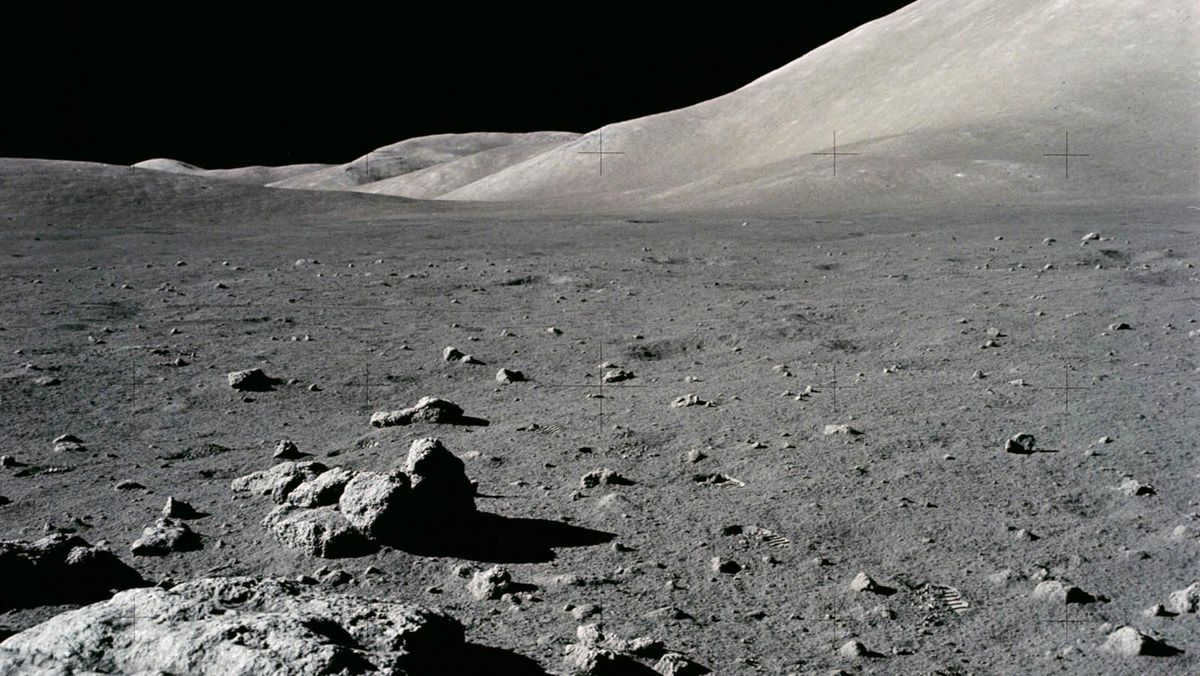
In July 1969, the Moon was explored by American astronauts who discovered that its surface was composed of various elements including dust, iron, basalt, silicon rocks, and other minerals. The Earth-facing side of the Moon appeared to have dark flecks, which were classified as seas, representing large craters and faults resulting from meteoric activity. On the other hand, the lighter areas were identified as mountains, as they stood higher than the depressions caused by meteorite impacts. Back in 1651, Giovanni Racchioli created a map of the Moon and labeled the lunar seas.
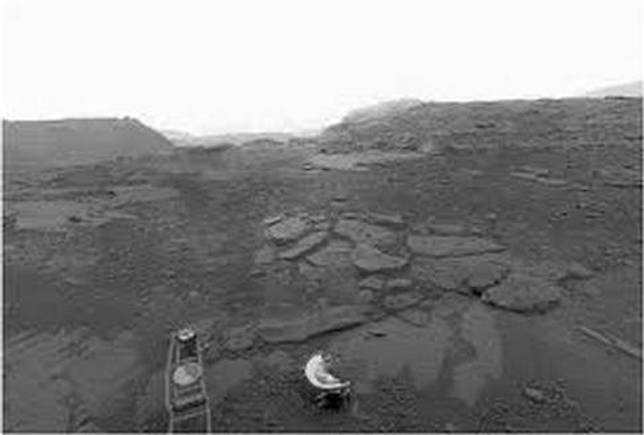
The Earth is much larger than the Moon. The information in the chart provided below illustrates this contrast. Despite the variation in size, it is worth mentioning that the Moon also experiences surface activity. As a result of lunar vibrations, new fissures are formed, which are visible in the photographs captured by lunar exploration vehicles. The highest level of lunar tremors reaches 5.5 on the scale, with an average duration of 10 minutes. In comparison, an earthquake of this magnitude typically lasts no longer than 2-3 minutes.
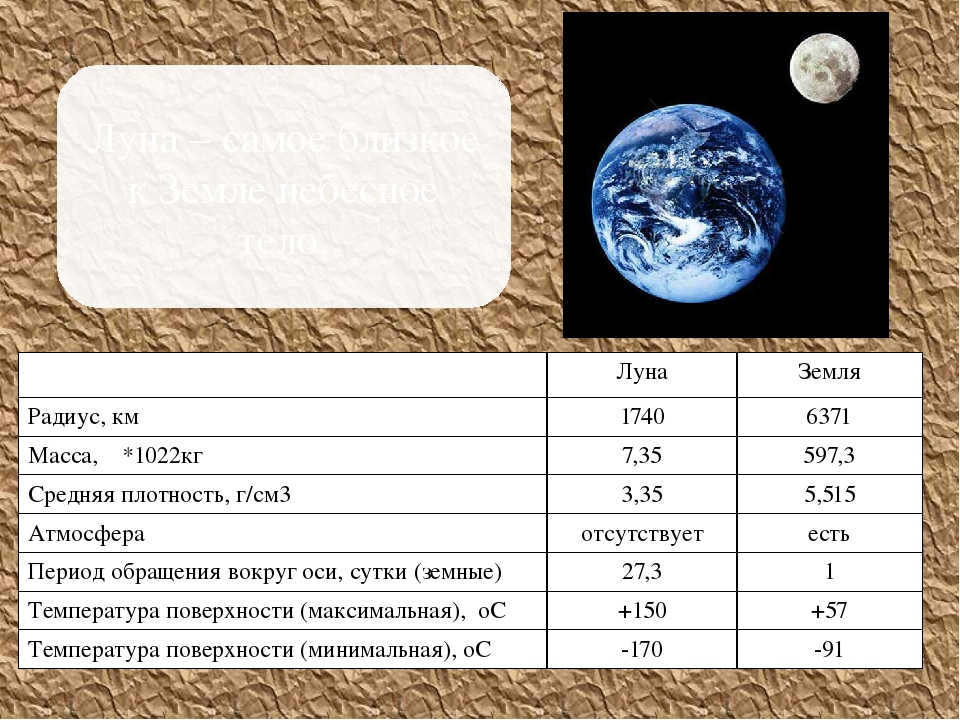
Phobos and Deimos

The initial discovery was made by Deimos. One hypothesis suggests that Phobos and Deimos were once asteroids that were captured and ended up in Mars’ orbit. Scientists also speculate that the presence of dust and small asteroids measuring 50-100 meters in radius between the two satellites may also be associated with the Red Planet, although direct evidence is currently lacking.
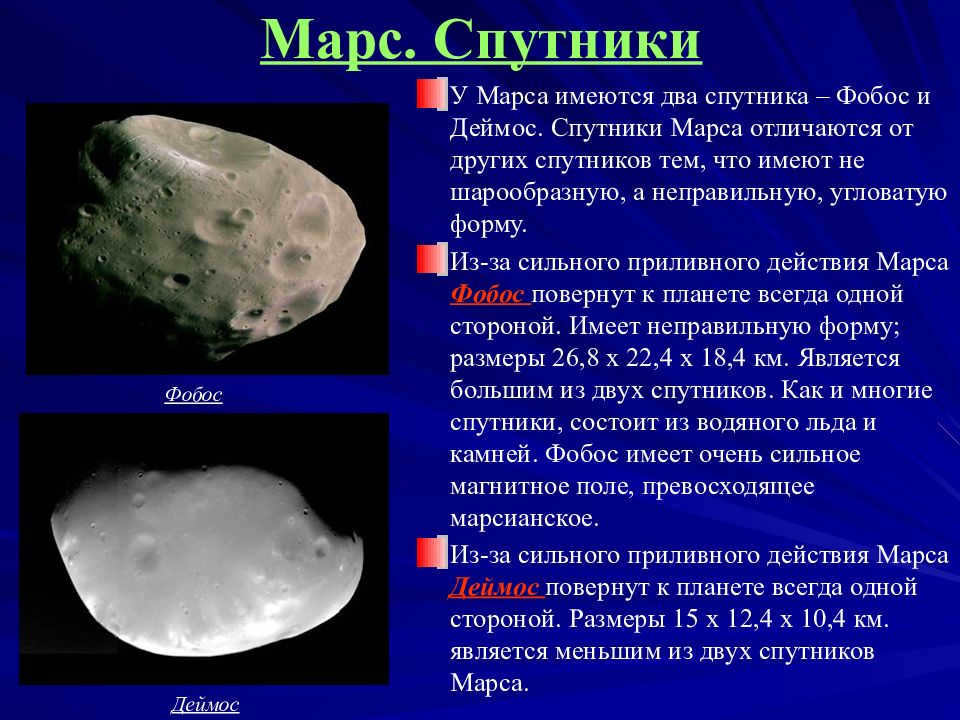
The satellites are monoliths on their surface. Additionally, Phobos exhibits weaker gravity, as evidenced by its low density. Through extensive research, scientists have determined that the top 100 meters of the satellite’s surface is covered in regolith. In terms of composition, both celestial bodies are 95% similar to asteroids. It is worth noting that Phobos and Deimos have highly irregular shapes, in contrast to the typical round shape of the Moon. Instead, these two bodies resemble sea pebbles, adorned with numerous craters.
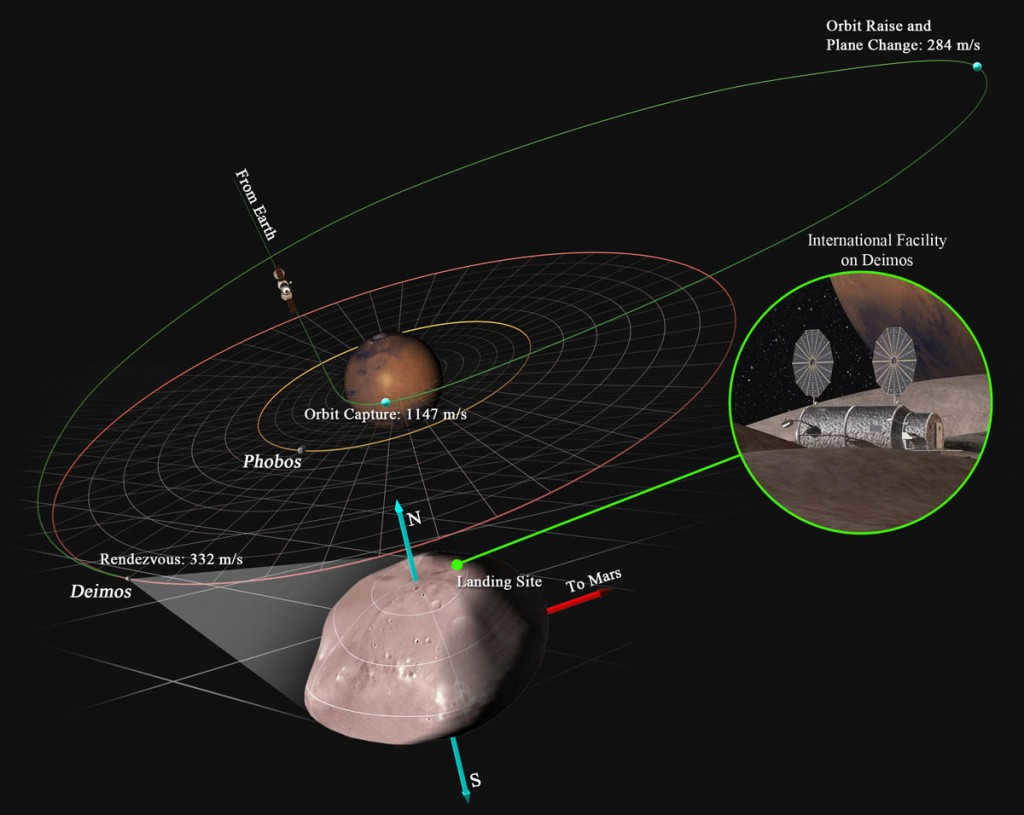
Due to its rapid rotation, Phobos is steadily moving closer to Mars. It is expected that the planet’s gravitational forces will eventually cause the moon to break apart, creating another crater on the surface of the red planet.
The planets belonging to the Earth group. – The Solar System consists of four planets: Mercury, Venus, Earth, and Mars [1]. Some rocky asteroids, like Vesta, have a similar structure and composition.
The terrestrial planets have high densities and are mainly made up of silicates and metallic iron (unlike the gas planets, rock-ice dwarf planets, Kuiper belt objects, and the Oort cloud). Earth, the largest terrestrial planet, is over 14 times less massive than Uranus, the least massive gas planet, but around 400 times more massive than the largest known Kuiper Belt object.
Planets in the Earth group are primarily composed of oxygen, silicon, iron, magnesium, aluminum, and other heavy elements.
All the terrestrial planets have the following structure:
- at the core, there is iron with a mixture of nickel.
- The Earth’s crust is created through the partial melting of the mantle and is composed of silicate rocks that are enriched with incompatible elements. Unlike the other planets in the Earth group, Mercury does not have a crust due to its destruction from meteorite bombardment. What sets Earth apart from the other planets in the Earth group is its high degree of chemical differentiation and the widespread presence of granites in its crust.
Among the terrestrial planets, Earth and Mars are the two farthest apart and they both have satellites. Unlike the giant planets, neither Earth nor Mars have rings.
Exoplanets Similar to Earth
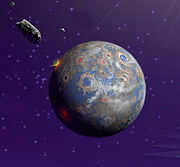
There is a widely held belief that planets similar to Earth are the most conducive to the emergence of life, which is why there is a great deal of public interest in their search. In December 2005, scientists from the Institute of Space Sciences in Pasadena, California announced the discovery of a star similar to the Sun, which is believed to have rocky planets orbiting around it [2]. Since then, several planets have been found that are only a few times larger than Earth and likely to have a solid surface.
One example of an Earth-like exoplanet is Super-Earth.
Also check out
Important information
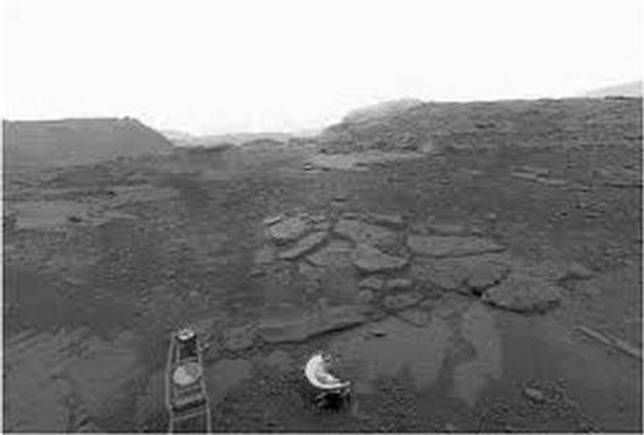
The planets in our solar system can be divided into two main groups based on their surfaces: gas giants and terrestrial planets. Terrestrial planets, also known as earth-group planets, have solid surfaces and are primarily made up of silicate compounds. In our solar system, there are only four terrestrial planets: Mars, Earth, Venus, and Mercury.
Brief overview of the terrestrial planets
The rocky planets are a group of celestial bodies that are situated within the region between Mars and Jupiter known as the asteroid belt. These planets earned their moniker “rocky” due to their composition of various solid rocks, minerals, and metals. Unlike Saturn, they generally lack the presence of satellites and rings. Surface features on these terrestrial planets include volcanoes, depressions, and craters, which are the result of impacts from other cosmic objects.
The following is a list of the rocky planets in order of their distance from the Sun:
However, if we were to compare their sizes and arrange them in ascending order, the list would appear as follows:
Characteristics of Solar System planets – a comparative analysis
The opposite direction of rotation around its axis is indicated by negative values of the rotation period, indicating that the planet is rotating in the opposite direction to its revolution around the Sun. This phenomenon is known as retrograde rotation. In our solar system, Venus, Uranus, and Pluto exhibit retrograde rotation.
Eccentricity is a parameter that measures the degree of ellipticity of a planet’s orbit. When e = 0, the orbit is a perfect circle.
| Earth | Mars | Jupiter | Saturn | Uranus | Neptune | |||
| Diameter (Earth = 1) | 0.382 | 0.949 | 1 | 0.532 | 11.209 | 9.44 | 4.007 | 3.883 |
| Diameter, km | 4878 | 12104 | 12756 | 6787 | 142800 | 120000 | 51118 | 49528 |
| Mass (Earth = 1) | 0.055 | 0.815 | 1 | 0.107 | 318 | 95 | 15 | 17 |
| Average distance from the Sun (AU) | 0.39 | 0.72 | 1 | 1.52 | 5.20 | 9.54 | 19.18 | 30.06 |
| Orbital period (Earth years) | 0.24 | 0.62 | 1 | 1.88 | 11.86 | 29.46 | 84.01 | 164.8 |
| Orbital eccentricity | 0.2056 | 0.0068 | 0.0167 | 0.0934 | 0.0483 | 0.0560 | 0.0461 | 0.0097 |
| Orbital velocity (km/sec) | 47.89 | 35.03 | 29.79 | 24.13 | 13.06 | 9.64 | 6.81 | 5.43 |
| Rotation period around its axis (in Earth days) | 58.65 | -243 | 1 | 1.03 | 0.41 | 0.44 | -0.72 | 0.72 |
| Axis tilt (degrees) | 0.0 | 177.4 | 23.45 | 23.98 | 3.08 | 26.73 | 97.92 | 28.8 |
| Average surface temperature (C) | -180 to 430 | 465 | -89 to 58 | -82 To 0 | -150 | -170 | -200 | -210 |
| Gravity at the equator (Earth = 1) | 0.38 | 0.9 | 1 | 0.38 | 2.64 | 0.93 | 0.89 | 1.12 |
| Space velocity (km/sec) | 4.25 | 10.36 | 11.18 | 5.02 | 59.54 | 35.49 | 21.29 | 23.71 |
| Average density (water = 1) | 5.43 | 5.25 | 5.52 | 3.93 | 1.33 | 0.71 | 1.24 | 1.67 |
| Atmospheric composition | none | CO 2 | N 2 + O 2 | CO 2 | H 2 + Ne | H 2 + Ne | H 2 + Not | H 2 + Not |
| Number of satellites | 0 | 0 | 1 | 2 | 63 | 62 | 27 | 13 |
| Rings | no | no | no | no | yes | yes | yes | yes |
Mercury
Mercury is the smallest and innermost planet in the Solar System. It is named after the Roman deity Mercury, the messenger of the gods. With a diameter of just 4,879 kilometers (3,032 miles), it is slightly larger than Earth’s moon. Mercury is also the second densest planet, after Earth. It has a thin atmosphere and no moons or rings. Mercury’s surface is covered in craters, mountains, and plains. It experiences extreme temperature variations, with daytime temperatures reaching up to 800 degrees Fahrenheit (430 degrees Celsius) and nighttime temperatures dropping to -290 degrees Fahrenheit (-180 degrees Celsius). Despite its small size, Mercury is an intriguing planet that continues to be studied and explored by scientists.
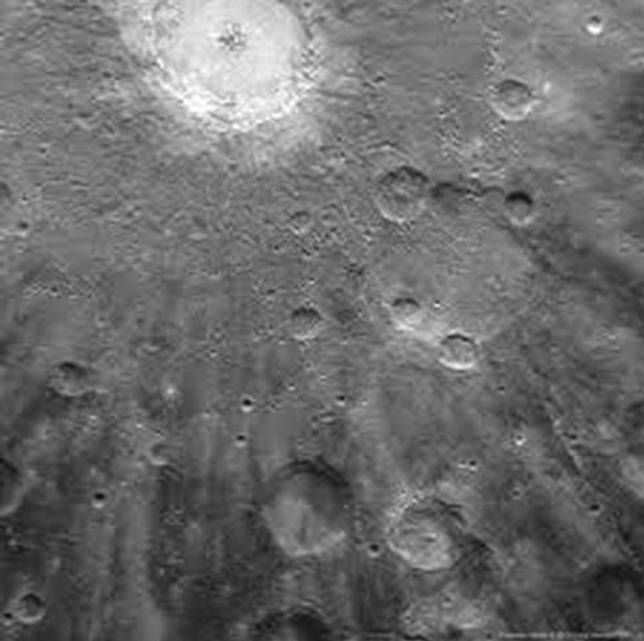
Mercury is the nearest planet to the Sun and also the smallest planet in the Solar System. Its radius measures 2,439.7 kilometers and it has a mass of 3.3-10 kilograms. The average density of Mercury is slightly lower than that of Earth, at 5.43 g/cm. The surface of Mercury experiences an acceleration of free fall of 3.70 m/s. The distance between Mercury and the Sun varies due to its highly elongated orbit, ranging from 45.9 million kilometers to 69.7 million kilometers.
Mercury is a unique planet in the solar system due to its rotation. One of its unique characteristics is that a day on Mercury is two-thirds of its own year. In other words, a Mercurian year consists of a day with a “tail”. This phenomenon is caused by the strong tidal influence of the Sun on the planet. Another interesting feature of Mercury is that near its perihelion (the closest point of its orbit to the Sun), the angular velocity of its orbital motion exceeds the angular velocity of its revolution around its axis. As a result, in the sky of Mercury, the Sun appears to stop and move in the opposite direction!
Mercury does not experience seasons because the plane of its axis is almost perpendicular to the plane of its orbit. This means that there are areas at the poles of the planet where sunlight does not reach.
The temperature on the planet Mercury experiences significant fluctuations, ranging from -180 degrees Celsius at night to a scorching +430 degrees Celsius during the day. These extreme temperature conditions contribute to the lack of a substantial atmosphere on Mercury, resulting in a very thin and nearly non-existent atmosphere.
An astronomical object known as the Sun
It is a rather melancholy realization, but the Sun is gradually depleting its reserves of nuclear fuel. In the course of billions of years, it will undergo expansion to become a colossal red star, engulfing the planets Mercury and Venus along the way. On Earth, temperatures will soar to such extreme levels that the oceans will evaporate into the vastness of space, transforming our planet into a dry and desolate world akin to Mercury’s current state. Once it has exhausted its entire supply of nuclear fusion, the Sun will dwindle in size until it becomes a white dwarf. Eventually, after millions of years, it will metamorphose into a black dwarf, a mere relic of its former self. Interestingly, the Sun and its nine planets did not even exist five billion years ago. There are numerous theories regarding the formation of the Sun and its planetary system from cosmic gas and dust clouds, but through billions of years of nuclear fusion, humanity now witnesses the Sun in its present form.
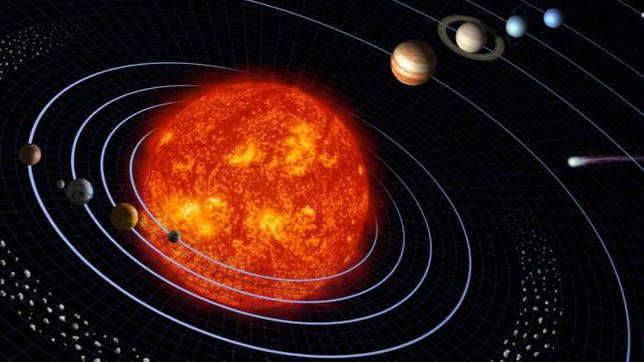
Venus
Often referred to as the morning star, Venus can be observed with the naked eye during sunset and sunrise.
Venus is Earth’s sister planet, sharing similarities in size, density, and mass. It has a radius of 6051.8 kilometers and a mass of 4.87-10
kg. With an average density of 5.24 g/cm.
and a free-fall acceleration of 8.87 meters per second at its surface.
Venus possesses a remarkably dense atmosphere, with a density 14 times less than water. It consists of 96% carbon dioxide, almost 4% nitrogen, and trace amounts of water vapor and oxygen totaling 0.1%. These atmospheric conditions result in a surface pressure of 93 atm and a temperature of 475 degrees Celsius. The greenhouse effect plays a significant role in maintaining this high temperature. Additionally, the Venusian atmosphere exhibits minimal temperature fluctuations between day and night due to its high thermal inertia.
The Planet Earth
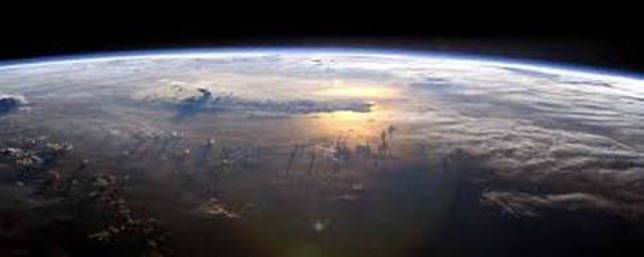
The Earth is a truly remarkable phenomenon within our solar system. Its atmosphere composition, distance from the Sun, size, and rotation periods all contribute to the existence of one of the most crucial elements for terrestrial life: liquid water.
With an average radius of 6371 kilometers, the Earth possesses a mass of 5.9736-10.
kg, an average density of 5.5153 g/cm.
, and a free-fall velocity of 9.780327 meters per second.
The Earth’s atmosphere is composed of 78% nitrogen and 21% oxygen, with the remaining percentage consisting of carbon dioxide, argon, and other elements.
Additionally, the Earth has one natural satellite, known as the Moon.
Classification of the Outer Group Planets
The classification of the solar system has traditionally been based on the categorization of planets, their moons, asteroids, and comets. However, the complexity of the solar system goes beyond these categories:
- There are satellites larger than Pluto and even two satellites larger than Mercury;
- Some small satellites are believed to have been captured asteroids;
- Comets can sometimes exhibit characteristics similar to asteroids;
- There are objects like Chiron that do not fit neatly into any category;
- The Earth/Moon and Pluto/Charon systems are sometimes referred to as “double planets”.
If there is a credible physical basis, other classifications can be assumed based on chemical composition and/or origin. However, this often results in either an excessive number of classes or too many exceptions. The key point is that many celestial bodies are unique, and our current understanding is not yet sufficient to establish precise categories. In the subsequent sections, I will utilize the conventional categorization.
The nine celestial bodies commonly known as planets are frequently further classified in the following manner:
- based on composition:
- terrestrial or rocky planets: Mercury, Venus, Earth, and Mars:
- The terrestrial group of planets primarily consists of rock and metal, with relatively high densities. They have a weak rotation, solid surfaces, no rings, and a small number of satellites.
- There are several small planets in our solar system, including Mercury, Venus, Earth, Mars, and Pluto.
- The diameter of these small planets is less than 13000 kilometers.
- On the other hand, the diameter of these planets is larger than 48000 km.
- There are inner planets in our solar system, such as Mercury, Venus, Earth, and Mars.
- On the other hand, the outer planets of our solar system include Jupiter, Saturn, Uranus, Neptune, and Pluto.
- There is a boundary between the inner and outer solar system, known as the asteroid belt, which is located between Mars and Jupiter.
- Among the inner planets, we have Mercury and Venus.
- These two planets are closer to the Sun compared to Earth.
- Interestingly, these planets also exhibit phases, just like the moon when observed from Earth.
- On the other hand, the outer planets are located farther from the Sun compared to Earth.
- Unlike the inner planets, these planets always appear full or near full.
- The five classical planets in our solar system include Mercury, Venus, Mars, Jupiter, and Saturn.
- These celestial bodies have been recognized and studied since ancient times.
- They can be observed without the need for any scientific instruments.
- In contrast, the newly discovered planets can only be seen through a telescope.
- These distant worlds are not visible to the naked eye.
Exploring Mars.
Following Earth comes Mars, where the Sun appears to be three times smaller compared to its size when viewed from Earth. Mars receives only a third of the amount of light that Earth receives. Additionally, this planet frequently experiences hurricanes that lift red dust from its surface. However, during summer days, temperatures on Mars can reach 17°C, similar to that on Earth. Mars has a distinctive red color due to the presence of iron oxide minerals in its soil, which repel the reddish-orange light of the Sun. In other words, the composition of Martian soil contains a significant amount of rusty iron, earning Mars the nickname “the red planet.” The Martian atmosphere is extremely thin, constituting only 1% of the density of Earth’s atmosphere. It primarily consists of carbon dioxide. Scientists speculate that Mars may have had rivers and liquid water about 2 billion years ago, as well as an atmosphere containing oxygen. This assumption is based on the fact that iron rusts when exposed to oxygen. It is plausible that Mars once had an atmosphere suitable for the development of life on the planet.
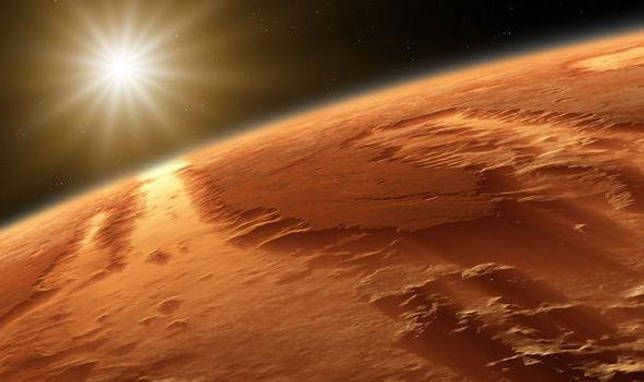
The chemical and physical parameters of the planets in the solar system are displayed in the following table, specifically for the planets belonging to the Earth group.
| Planet | Atmospheric chemistry | Physical parameters | |||||
| CO2 | N2 | O2 | Ar | H2O | Pressure, atm. | Temperature, C | |
| Earth | 0.03 | 78 | 21 | 0.93 | 0.1-1.0 | 1 | From -30 to + 40 |
| Venus | 95 | 3-5 | 0.001 | 0.01 | 0.01-0.1 | 90 | 470 |
| Mars | 95 | 2-3 | 0.1-0.4 | 1-2 | 0.01- 0.1 | 0.05 | From -70 to 0 |
The atmospheric chemistry differs greatly among the three planets, as can be seen from the table above.

In this tutorial, we will explore the overall attributes of the planets in the Earth group. We will delve into the atmospheres of Mercury, Venus, and Mars, examining the chemical elements that compose their surfaces. Additionally, we will analyze distinctive characteristics of the topography found on these Earth group planets.
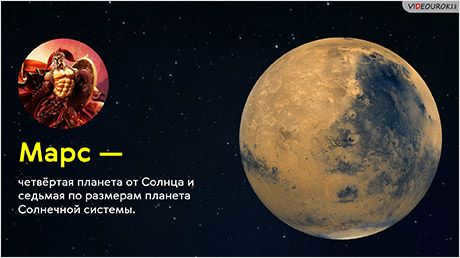
Unfortunately, it is currently not possible to view or share the video tutorial with students
In order to access this and other video tutorials in the package, you will need to add it to your personal account.
Unlock amazing possibilities


Outline of the Earth Group Planets Lesson
In our previous lesson, we examined the primary characteristics and structure of the Earth and its companion, the Moon.
Now, let’s shift our focus to the other members of the terrestrial group of planets. Our exploration will commence with Mercury, the planet situated closest to the Sun. Mercury holds the distinction of being the smallest planet within our solar system. Its size is more akin to that of the Moon rather than the Earth. Similar to the Moon, Mercury’s surface is adorned with numerous impact craters, many of which bear the names of renowned cultural figures such as Dostoevsky, Rembrandt, Tolstoy, and others.
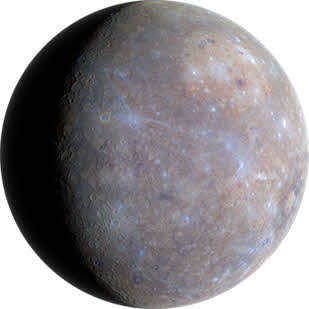
Similar to the lunar surface, the lowlands of the Zhara Plain are filled with hardened lava. One notable feature is the Plain of Heat, which is one of the largest impact craters in the solar system with a diameter of approximately 1550 kilometers. Another unique feature in the Zhara Plain is a structure called Pantheon, which consists of a series of grooves that resemble the ribbed dome of the Roman Pantheon. This structure is not found anywhere else in the Solar System.
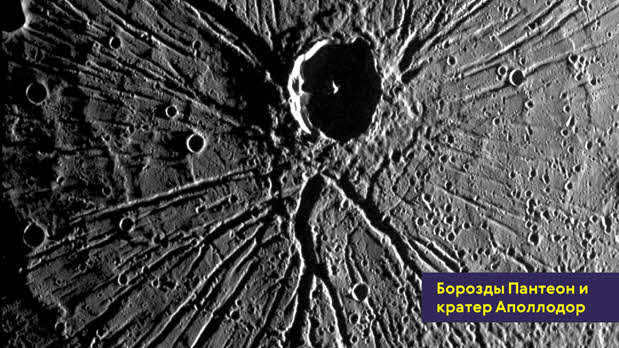
Observing Mercury from Earth can be challenging due to its constant hiding in the Sun’s rays. The planet only briefly emerges against the backdrop of the morning dawn or the glow of the evening sunset. As a result, ancient civilizations struggled to recognize that the relatively bright evening and morning stars were actually the same celestial body. This led to the development of multiple names for Mercury among different cultures. The Egyptians referred to it as Seth and Horus, the Indians called it Budha and Rohini, and the Greeks identified it as Apollo and Hermes.
Due to its close proximity to the Sun, Mercury possesses an extremely thin atmosphere, with a pressure that is nearly a quadrillion times lower than that of Earth’s atmosphere. Consequently, Mercury experiences significant temperature variations. In the daytime, the surface temperature on the planet can reach 700 Kelvin, while at night it can drop to 100 Kelvin.
Mercury’s average distance from the Sun is approximately 57.9 million kilometers. It completes one orbit around the Sun in 88 Earth days, while its rotation period around its axis is 58.646 days, accounting for nearly two-thirds of Mercury’s year.
Mercury’s rotation axis has a tilt angle that is nearly perpendicular to its orbit, resulting in the bottoms of the near-polar craters never being exposed to sunlight. These regions serve as deposits for a mixture of water ice and rock.
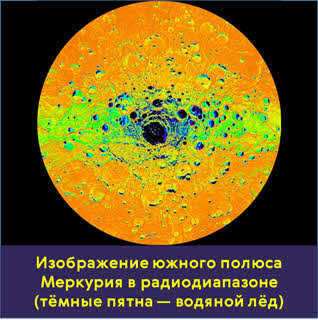
The average density of the planet is approximately equal to 5.43 times the density of water, which is slightly lower than the average density of Earth. This suggests that Mercury, despite being smaller in size, has a substantial core made primarily of iron and nickel. In fact, this core accounts for 83% of the planet’s total volume.
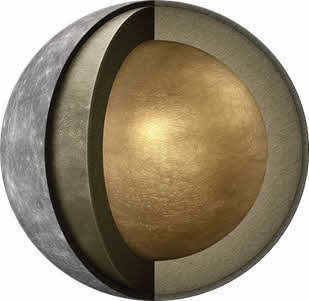
Mercury possesses a central region encompassed by a layer of silicate mantle measuring approximately 500-600 kilometers in thickness. This is succeeded by the crust, which spans between 100 and 300 kilometers. In terms of magnetic field, Mercury exhibits a feeble force, approximately 100 times less potent than that of Earth.
During 2012, a fascinating arrangement of impact craters on Mercury was discovered. Their formation bears a striking resemblance to the iconic countenance of Mickey Mouse from the renowned cartoon.
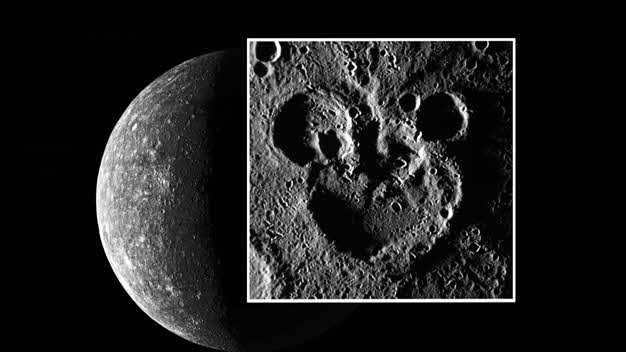
Venus, the second planet in our solar system, is situated approximately 108.2 million kilometers away from the Sun. It was given its name in honor of the ancient Roman goddess of love. Venus can be easily observed with the naked eye during the moments just before sunrise in the eastern sky or after sunset in the western sky. It is categorized as a planet that resembles Earth and is often referred to as “Earth’s sister” due to the similarities in their size and composition. The average radius of Venus measures around 6051.8 kilometers, which is nearly 95% of Earth’s radius. Additionally, Venus has an average density of 5.24 g/cm 3 . However, it is important to note that the conditions on these two planets differ significantly.
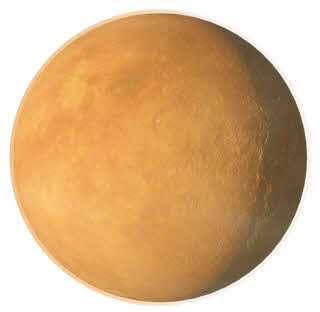
However, the extreme heat is not the only challenge on Venus. The atmospheric pressure on this planet is a staggering 93 times higher than that of Earth. Furthermore, Venus lacks any significant bodies of water, so while one may complain about the heat, there is no need to worry about humidity. The planet’s atmosphere is hot and arid, resembling a vast desert. Unfortunately, the weather on Venus is far from pleasant, as it experiences constant rainfall of sulfuric acid across its entire expanse. The only silver lining is that this acid rain evaporates before reaching the planet’s surface.
Research conducted using radio telescopes and the Soviet Venera spacecraft has revealed that the majority of Venus’s surface consists of expansive plains. The highest mountains on the planet, known as the Maxwell Mountains, soar to a staggering height of 11 kilometers above the average surface level.
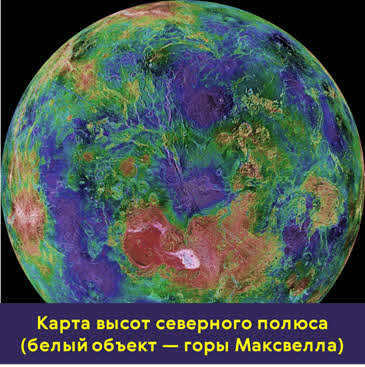
There have been observations of craters on Venus with diameters that can reach hundreds of kilometers, although they are quite rare. This indicates that the planet’s surface is relatively young, estimated to be around 500 million years old. Notably, these craters have been named after prominent women from around the world, such as Akhmatova, Voynich, Duncan, and Orlova. Additionally, surface mapping has uncovered extensive elevations on Venus, including the Ishtar and Aphrodite Terrae, which are comparable in size to Earth’s continents.
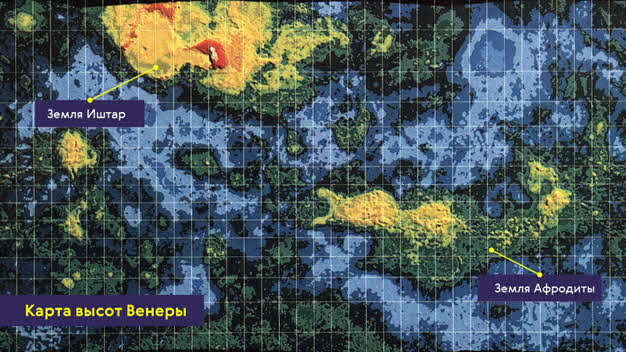
The lack of a significant magnetic field on Venus is thought to be due to its slow retrograde rotation. Unlike most planets, Venus rotates clockwise around its axis. It takes Venus 243,023 Earth days to complete one rotation, while it orbits the Sun in 224,698 Earth days.
Various models have been proposed to explain the internal structure of Venus. The most plausible one suggests that the planet consists of three layers. The first layer is the crust, which is approximately 16 kilometers thick. Below that is the mantle, a silicate shell that extends to a depth of around 3300 kilometers, where it meets the iron core. The core makes up about a quarter of the planet’s total mass.
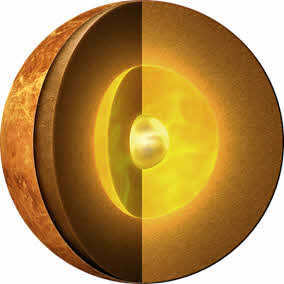
The Venera-15 and Venera-16 instruments, as well as the U.S. Magellan spacecraft, have unveiled a multitude of ancient volcanoes, arachnoids, and mountains on Venus.
Mars, the fourth planet from the Sun and the seventh largest in the solar system, derives its name from the ancient Roman god of war. Situated at a distance approximately one and a half times greater than that of Earth from the Sun, Mars is an intriguing celestial body.
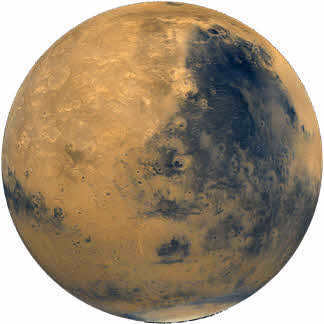
When observed from Earth, Mars appears as a vibrant red star. A Martian year lasts for approximately 686.98 days, while its rotation period is around 24 hours, 37 minutes, and 22.7 seconds. In terms of size and mass, Mars falls somewhere between Earth and the Moon, with a radius about twice as small and a mass nine times smaller than Earth’s. Additionally, Mars has the lowest average density among all the planets in the Earth group.
Since the 1960s, Mars has been extensively explored by multiple space agencies, including the USSR, the USA, the European Space Agency, and India. As a result, Mars is now the second most studied planet in the solar system, following Earth.
The Martian terrain is characterized by various unique features, such as white polar caps, numerous meteoric craters, and dark spots resembling seas against an orange-red backdrop.
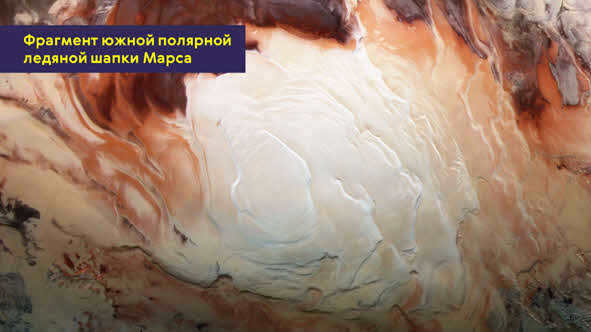
Despite having an atmosphere, Mars has a very thin one, resulting in significant temperature fluctuations. During the day at the equator, the temperature can rise to +20°C, while at night it drops to -65°C. In winter, temperatures at the pole can drop to as low as -153°C, with snow and frost observed on the Martian surface.
Additionally, dust storms periodically occur on the red planet, moving at speeds of up to 70 km/h. These storms can last up to 100 days and result in approximately one million tons of dust being lifted into the Martian atmosphere.
Millions of years ago, Mars experienced powerful volcanic activity and dramatic tectonic movements, resulting in the formation of massive volcanoes. Among them, Mount Olympus stands out as the most colossal, reaching a staggering height of 21.2 kilometers from its base and an impressive 26 kilometers from its foot to its summit. This makes it the tallest volcano in the entire solar system, both in terms of absolute height and relative elevation.
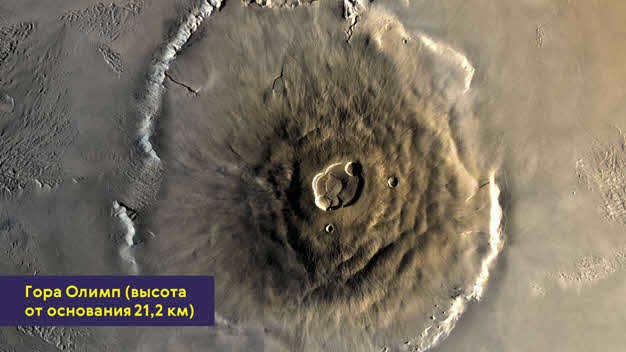
Mars is home to a multitude of canyons, including the impressive Mariner Valley. Stretching a staggering 4,500 kilometers in length, this canyon system boasts a width of 200 kilometers and a depth of 11 kilometers. In fact, it surpasses the renowned Grand Canyon in both length and size, being ten times longer, seven times wider, and seven times deeper. As such, it holds the distinction of being the largest known canyon among all the planets.
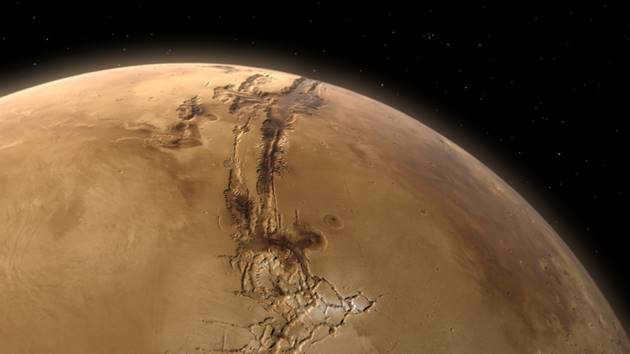
According to different estimations, it is believed that Mars is composed of a crust that is approximately 50 kilometers thick, a silicate mantle, and a core with a radius of up to 1800 kilometers, based on current models of its internal structure.
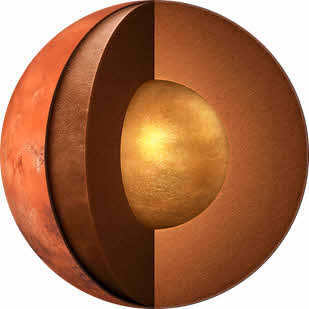
The central part of Mars contains a mix of iron and sulfur, creating a partially liquid core. While Mars currently lacks a significant magnetic field, it had a similar field to Earth in the past.
Mars possesses two small moons, Phobos and Deimos, which derive their names from the ancient Greek words for “fear” and “terror.” These names originate from Ares, the Greek god of war, and his two sons who accompanied him into battle. It is likely that Phobos and Deimos were once asteroids that became trapped in Mars’ gravitational pull when they came close to the planet. The presence of numerous meteorite craters on their surfaces supports this theory. Stickney, the largest crater on Phobos, is nearly as large as the moon itself. The impact that formed this crater was so powerful that it nearly shattered the satellite.

This video tutorial will discuss the composition and distinctive features of the planets in the Earth-group. We will explore the chemical elements that constitute the surfaces of these planets and examine the unique characteristics of their atmospheres.
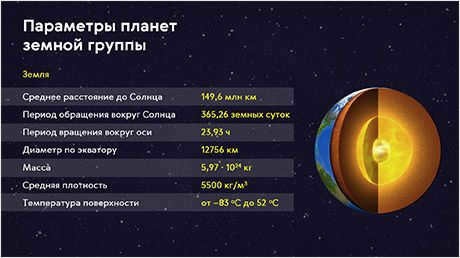
Currently, it is not possible for you to watch or distribute the instructional video to students
In order to gain access to this and other video lessons included in the package, you will need to include it in your personal account.
Unlock amazing possibilities


Prospectus for the lesson “Planets in the Earth group”
Mercury, being the planet closest to the Sun, often remains hidden in its brilliant light. Consequently, observing Mercury from Earth poses quite a challenge. It only fleetingly emerges amidst the backdrop of the early morning or the radiance of the evening twilight.
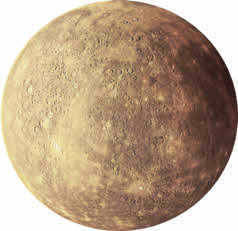
It is believed that the discovery of Mercury was made by ancient tribes residing in the valleys of the Nile, Tigris, and Euphrates. However, identifying the relatively bright evening and morning stars as one and the same celestial body was not an easy task. As a result, these ancient civilizations gave it two different names: the Egyptians referred to it as Seth and Gor, the Indians called it Budha and Rohini, and the Greeks named it Apollo and Hermes (in Roman mythology, Hermes was associated with the god Mercury).
In terms of its size, Mercury is more similar to the Moon than to the Earth. Its surface is filled with impact craters, many of which are named after prominent figures in world culture, such as Rembrandt, Beethoven, Homer, Dostoevsky, Pushkin, Tolstoy, and others.
It is worth noting that Mercury does not have a natural satellite. Due to its close proximity to the Sun, Mercury has a very minimal atmosphere.
As a result, the planet’s surface is exposed to the intense heat of the sun during the day and the extreme cold of space at night. The temperature on Mercury can reach a scorching 440 ℃ during the day and plummet to a bone-chilling -183 ℃ at night.
Mercury’s density is approximately 5.4 times that of water. This higher density is attributed to the planet’s massive iron-nickel core, which comprises a significant portion of its composition. Additionally, the presence of a weak magnetic field on Mercury, detected by the Mariner 10 spacecraft, and fluctuations in the planet’s rotation suggest that its core is in a liquid state.
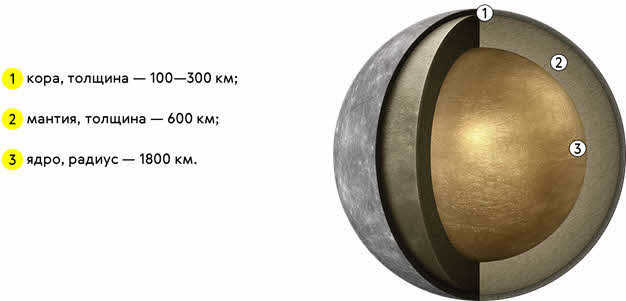
Simultaneously, it possesses a much greater mass in comparison to the core of other celestial bodies and accounts for 3/4 of the diameter of the planet Mercury.
This celestial body completes its orbit around the Sun in a span of 88 Earth days, while its rotational period takes over 58 Earth days, equating to nearly 2/3 of a full Mercurian year.
Due to the perpendicular alignment of Mercury’s rotation axis to its orbit, the bottoms of the polar craters are never illuminated by the Sun. These regions function as storage sites for a combination of water ice and rock.
In 2012, scientists made a fascinating discovery regarding the pattern of craters on Mercury. The arrangement of these craters bears a resemblance to the iconic face of Mickey Mouse from the beloved Walt Disney Company cartoon.
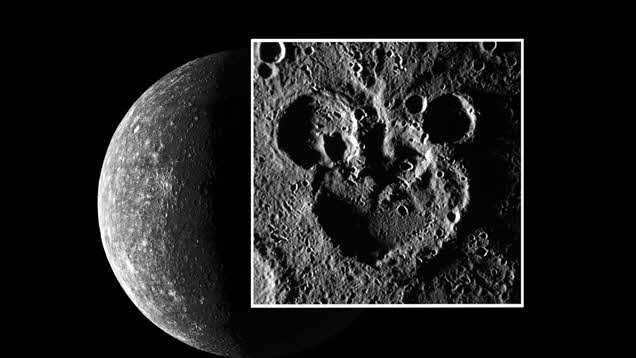
Venus, the second planet in our solar system, derives its name from the ancient Roman goddess of love. This celestial body can be easily seen by the naked eye right before sunrise in the eastern sky or after sunset in the western sky. Often referred to as Earth’s sister, Venus shares similar size and composition with our home planet. Nevertheless, the environmental conditions on Venus drastically differ from those on Earth.
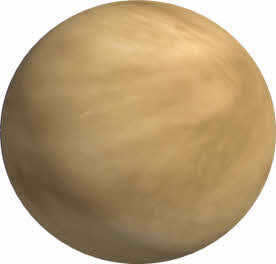
Venus is perpetually shrouded in a dense layer of clouds, primarily composed of highly concentrated sulfuric acid, which results in the absence of clear skies on the planet. Additionally, Venus holds the distinction of being the hottest planet in our solar system. With surface temperatures reaching a scorching 464℃, the extreme heat is unrelenting, maintaining a consistent level from the equator to the poles, throughout both day and night.
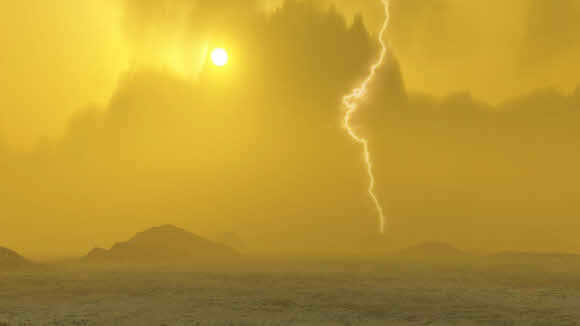
Plains dominate the majority of the Venusian surface, while the Maxwell Mountains proudly tower 11 kilometers above the average elevation. Although craters are scarce on Venus, those that do exist can span hundreds of kilometers in diameter. Notably, these craters have been named after remarkable women from around the world, including Akhmatova, Voynich, Duncan, and Orlova. Extensive mapping efforts have unveiled expansive highlands on Venus, with the most prominent being the Ishtar Terra and the Aphrodite Terra, which rival Earth’s continents in size.
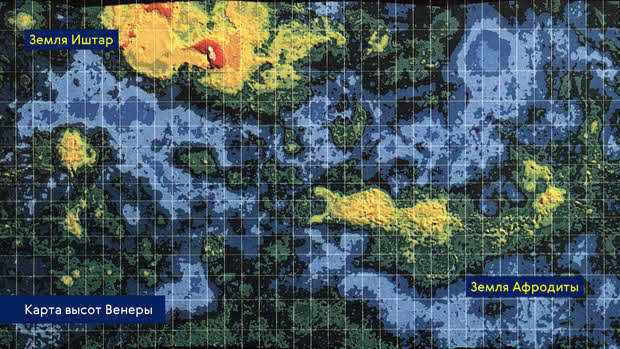
Venus lacks a significant magnetic field, which some scientists believe is due to its slow retrograde rotation. Unlike most planets, Venus rotates clockwise around its axis. It takes about 243 Earth days for Venus to complete one rotation, while it orbits the Sun in nearly 225 Earth days. Alternatively, other scientists attribute the absence of a magnetic field to Venus having a solid core.
About 500 million years ago, Venus experienced a global geological catastrophe. Numerous active volcanoes erupted, releasing massive amounts of lava that covered the entire surface of the planet.
The Earth is the third planet in the solar system and ranks fifth in terms of size. When viewed from space, our planet appears as a stunning blue sphere, featuring visible continents and oceans peeking through the clouds.
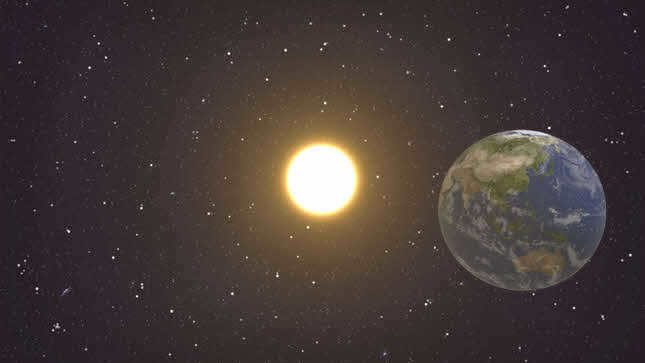
The Earth rotates around its axis in approximately 24 hours, while it takes a little over 365 Earth days for the planet to orbit the Sun. Unlike Venus and Mercury, the Earth has its own natural satellite known as the Moon.
While you may be familiar with the details of the Earth’s surface, we will now focus on the structure of its interior and atmosphere.
Despite living on Earth and it being right beneath our feet, studying its composition has proven to be quite challenging. With an average radius of 6,371 kilometers, the deepest well ever drilled on Earth is only just over 12 kilometers deep.
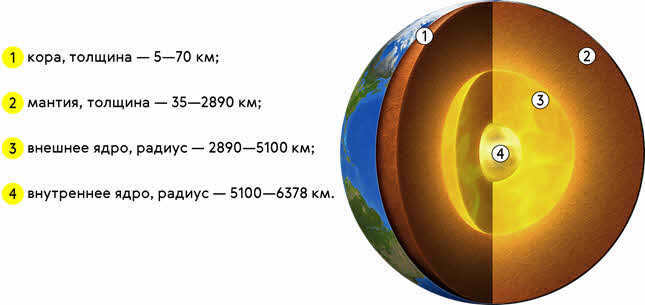
The solid crust, which has an average depth of 35 kilometers, serves as the thinnest outer layer. A distinct boundary separates the crust from the mantle, which follows it. The densest part of the planet’s interior is the core. Its radius is approximately 55% of the Earth’s radius, and its mass accounts for about 30% of the entire planet’s mass. The Earth’s core consists of an outer liquid core and a solid inner core.
Similar to other planets, the Earth is encompassed by a gaseous envelope known as the atmosphere. This atmosphere extends about 2,000 kilometers into space.
The Earth’s atmosphere has undergone significant changes over the course of its four billion-year history. Initially, it is believed that the atmosphere was filled with toxic compounds such as hydrogen, carbon, oxygen, and nitrogen, making it inhospitable to most forms of life. However, over hundreds of millions of years, the composition of the atmosphere has evolved.
Today, the atmosphere primarily consists of nitrogen (78%), oxygen (21%), and trace amounts of other gases such as argon and carbon dioxide.
The atmosphere can be divided into several distinct layers based on its composition.
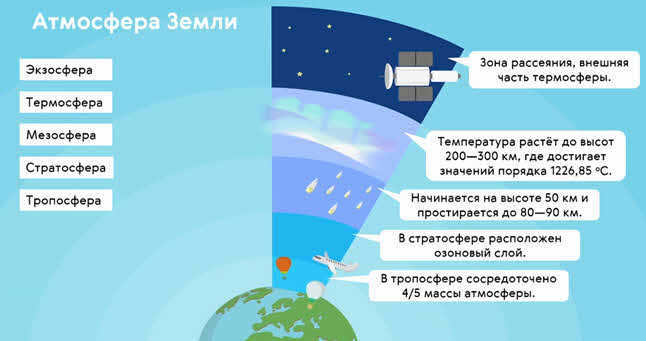
The troposphere, located on Earth itself, spans and contains 4/5 of the total mass of atmospheric air. This is where the weather processes take place. Next is the stratosphere, which houses the ozone layer. The ozone layer absorbs harmful ultraviolet rays from the Sun, which can be detrimental to all forms of life on Earth.
Above the stratosphere is the mesosphere, which is appropriately named as the “intermediate sphere” in Greek.
Further up, extending up to approximately 800 kilometers, is the thermosphere. It is named as such because the temperature rises to 1500oC up to a height of 200-300 kilometers due to the ionization of gases by ultraviolet and X-rays.
Then comes the exosphere, which smoothly transitions into outer space.
The Earth’s surface is shielded from extreme heat and cold by the protective air shell. This shell acts like a cozy blanket, trapping the Sun’s heat and preventing it from escaping. Additionally, the atmosphere acts as a shield, safeguarding the Earth from solid objects falling from outer space.
When it comes to magnetic fields, the Earth boasts the largest one among all the planets in its group. This magnetic field serves as a defense against the high-speed charged particles ejected by the Sun into space.
Mars, the fourth planet in our solar system and the final member of the Earth group, is situated about one and a half times further from the Sun than Earth.
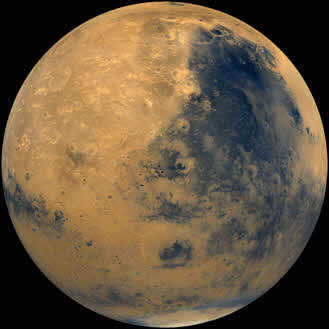
From an observer’s perspective, it appears as a vibrant crimson star. Mars has a year that spans 687 days on Earth, and its rotational period is only 38 minutes longer than Earth’s. In terms of size and mass, Mars falls between Earth and the Moon, with a radius approximately twice as large and a mass nine times smaller than Earth’s.
Images captured by spacecraft reveal that Mars is a barren desert, with vast stretches of reddish sand and scattered rocks. The surface of Mars obtains its red hue from the high concentration of iron oxides in the soil.
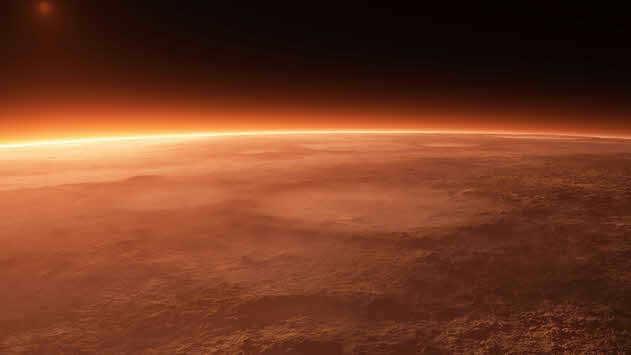
Despite the presence of an atmosphere, Mars has a very thin one, leading to significant fluctuations in temperature. During the day at the equator, temperatures can reach as high as 15 ℃, but plummet to -65 ℃ at night. In the winter, temperatures can even drop to -125 ℃, resulting in the formation of snow and frost on the surface of the planet. However, due to the low atmospheric pressure, water cannot exist in a liquid state and instead boils and evaporates at 2 ℃.
One piece of evidence suggesting the past existence of liquid water on Mars is the presence of dry riverbeds with streamlined islands, as well as rocks that bear a striking resemblance to those found in Earth’s rivers.
In the ancient history of Mars, massive volcanoes were formed due to volcanic activities and tectonic movements. One of the most renowned volcanoes is Mount Olympus, boasting a remarkable diameter of approximately 540 kilometers and an impressive height of around 22 kilometers. This extraordinary mountain stands as the second tallest peak ever discovered within the solar system.
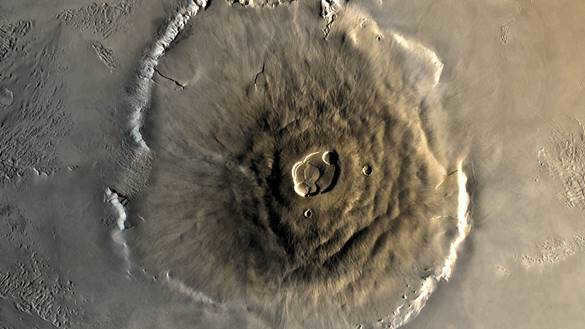
Mars is also home to a multitude of canyons, including the massive Mariner Valley canyon system, which stretches for almost 4,500 kilometers. There are also numerous impact craters on the planet’s surface. These craters have undergone more erosion compared to those on the moon, likely due to the presence of water that once caused extensive flooding on Mars.
Scientists believe that Mars consists of a crust with an average thickness of approximately fifty kilometers, a silicate mantle, and a partially liquid core composed primarily of iron and sulfur. While Mars currently has a very weak magnetic field, it is believed that in the past, it had a magnetic field similar to that of Earth.
